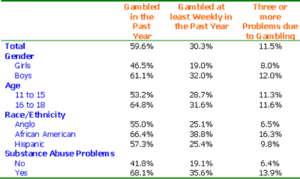The Wager, Vol. 7(1) – Gambling Behavior among Youths in Texas Youth Commission Facilities
The prevalence rate for problem gambling among prison inmates exceeds that of the general population (Shaffer, Hall, & VanderBilt, 1999) as does the prevalence rate for youths (Shaffer & Hall, 1996). But what about youths who also are criminal offenders? Do these young people suffer doubly?
The Texas Commission on Alcohol and Drug Abuse recently surveyed the gambling experience of youths who have been sent to Texas Youth Commission (TYC) facilities (Wallisch & Kerber, 2001). This WAGER reviews participants’ self-reported gambling behavior in the year prior to incarceration to explore whether or not criminally offending youths might have a higher risk for developing problem gambling behavior than non-offending youth.
Participants were 1,026 randomly selected youths interviewed by public school teachers at a TYC intake facility. The interviewers were not affiliated with TYC and were specially trained to conduct the interview. The interview collected information on “licit and illicit substance use, criminal history, past substance abuse treatment experiences, and current motivation for treatment, family and peer relations, gang involvement and gang activities, physical and mental health, gambling behaviors, experiences in school, and demographics” (Wallisch & Kerber, 2001).
Problem gambling was identified from their responses to five questions from the South Oaks Gambling Screen (Lesieur & Blume, 1987) and one additional question pertaining to gambling. Individuals who reported positive responses to three or more questions were considered to have a problem with gambling. Information pertaining to past-year gambling, weekly gambling in the past year, and gambling problems is summarized in Table 1.
Table 1. Percentage of Youths Reporting Past Year, Weekly, and Gambling Problems by Demographic Group and Substance Abuse
In Wallisch and Kerber (2001), 12% of male and 8% of female criminal youths reported positive responses to at least three questions about gambling-related problems. Consistently, past year and weekly past year gambling rates were higher for boys (61% & 32%) than for girls (47% & 19%). Corresponding rates among non-criminal Minnesotan youth indicate that between 4.6 and 15.0% of 12th grade boys reported problems associated with gambling and between 2.6 and 5.2% of girls reported problems associated with gambling (Stinchfield, 2000). Similarly, 83% of 12th grade boys gambled in the past year and 21.7% of 12th grade boys gambled weekly. Stinchfield (2000) also showed that 60% of 12th grade girls gambled in the past year and 7.3% of 12th grade girls gambled weekly. Thus, TYC youths did not consistently exceed non-criminal youths in their gambling behaviors.
This study reports findings that are quite important; however, there are some limitations. First is the limited sample. The authors note that the youths admitted to TYC facilities have lengthy criminal records and the findings will not generalize to typical youth detainment centers nationally, or even to others in Texas. Second, Wallisch and Kerber (2001) reported selecting five SOGS items to determine whether or not youths had problems with gambling. It is unclear why only these items were used and what validity these items have when separated from the entire SOGS instrument. Third, the reported method of gambling problem identification cannot distinguish (1) level 2 or problem gambling from (2) level 3 or pathological gambling. This makes it difficult to compare the results to the prevalence of problem (level 2) and pathological (level 3) gambling reported in the literature (e.g., Shaffer & Hall, 1996). Fourth, the authors used items from the SOGS for adults when alternatives (e.g., SOGS-RA; Winters, Stinchfield, & Fulkerson, 1993) designed for adolescents are available.
Wallisch and Kerber (2001) explored gambling behavior among criminally offending youths. This research is important because these participants belong to two demographic groups (i.e., criminal and youth) or strata that are highly susceptible to problem and pathological gambling. Because a non-traditional measure of problem gambling was used, it is difficult to compare these findings to meta-analytically identified prevalence rates (e.g. (Shaffer & Hall, 1996). The question of additive risk, then, remains open. More research is needed to determine whether or not risk for developing pathological gambling is increased among criminal youth.
References
Lesieur, H. R., & Blume, S. B. (1987). The South Oaks Gambling Screen (SOGS): A new instrument for the identification of pathological gamblers. American Journal of Psychiatry, 144, 1184-1188.
Shaffer, H. J., & Hall, M. H. (1996). Estimating the prevalence of adolescent gambling disorders: A quantitative synthesis and guide toward standard gambling nomenclature. Journal of Gambling Studies, 12(2), 193-214.
Shaffer, H. J., Hall, M. H., & VanderBilt, J. (1999). Estimating the prevalence of disordered gambling behavior in the United States and Canada: A research synthesis. American Journal of Public Health, 89, 1369-1376.
Stinchfield, R. (2000). Gambling and correlates of gambling among Minnesota public school students. Journal of Gambling Studies, 16(2/3), 153-173.
Wallisch, L. S., & Kerber, L. (2001). Substance use and delinquency among youths entering Texas Youth Commission facilities: 2000-2001. Austin, Texas: Texas Commission on Alcohol and Drug Abuse.
Winters, K. C., Stinchfield, R., & Fulkerson, J. (1993). Toward the development of an adolescent gambling problem severity scale. Journal of Gambling Studies, 9, 63-84.
